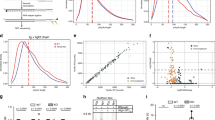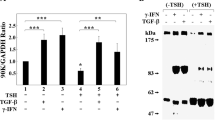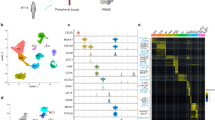Abstract
Although cells of the immune system can produce thyroid-stimulating hormone (TSH), the significance of that remains unclear. Using 5′ rapid amplification of cDNA ends (RACE), we show that mouse bone marrow (BM) cells produce a novel in-frame TSHβ splice variant generated from a portion of intron 4 with all of the coding region of exon 5, but none of exon 4. The TSHβ splice variant gene was expressed at low levels in the pituitary, but at high levels in the BM and the thyroid, and the protein was secreted from transfected Chinese hamster ovary (CHO) cells. Immunoprecipitation identified an 8 kDa product in lysates of CHO cells transfected with the novel TSHβ construct, and a 17 kDa product in lysates of CHO cells transfected with the native TSHβ construct. The splice variant TSHβ protein elicited a cAMP response from FRTL-5 thyroid follicular cells and a mouse alveolar macrophage (AM) cell line. Expression of the TSHβ splice variant, but not the native form of TSHβ, was significantly upregulated in the thyroid during systemic virus infection. These studies characterize the first functional splice variant of TSHβ, which may contribute to the metabolic regulation during immunological stress, and may offer a new perspective for understanding autoimmune thyroiditis.
This is a preview of subscription content, access via your institution
Access options
Subscribe to this journal
Receive 6 digital issues and online access to articles
$119.00 per year
only $19.83 per issue
Buy this article
- Purchase on Springer Link
- Instant access to full article PDF
Prices may be subject to local taxes which are calculated during checkout




Similar content being viewed by others
References
Kelly GS . Peripheral metabolism of thyroid hormones: a review. Altern Med Rev 2000; 5: 306–333.
Szkudlinski MW, Fremont V, Ronin C, Weintraub BD . Thyroid-stimulating hormone and thyroid-stimulating hormone receptor structure-function relationships. Physiol Rev 2002; 82: 473–502.
Gordon DF, Wood WM, Ridgway EC . Organization and nucleotide sequence of the gene encoding the beta-subunit of murine thyrotropin. DNA 1988; 7: 17–26.
Wood WM, Gordon DF, Ridgway EC . Expression of the beta-subunit gene of murine thyrotropin results in multiple messenger ribonucleic acid species which are generated by alternative exon splicing. Mol Endocrinol 1987; 1: 875–883.
Wolf O, Kourides IA, Gurr JA . Expression of the gene for the beta subunit of mouse thyrotropin results in multiple mRNAs differing in their 5′-untranslated regions. J Biol Chem 1987; 262: 16596–16603.
Shupnik MA . Thyroid hormone suppression of pituitary hormone gene expression. Rev Endocr Metab Disord 2000; 1: 35–42.
Kruger TE, Smith LR, Harbour DV, Blalock JE . Thyrotropin: an endogenous regulator of the in vitro immune response. J Immunol 1989; 142: 744–747.
Smith EM, Phan M, Kruger TE, Coppenhaver DH, Blalock JE . Human lymphocyte production of immunoreactive thyrotropin. Proc Natl Acad Sci USA 1983; 80: 6010–6013.
Harbour DV, Kruger TE, Coppenhaver D, Smith EM, Meyer III WJ . Differential expression and regulation of thyrotropin (TSH) in T cell lines. Mol Cell Endocrinol 1989; 64: 229–241.
Kelley KW, Weigent DA, Kooijman R . Protein hormones and immunity. Brain Behav Immun 2007; 21: 384–392.
Fabris N, Mocchegiani E, Provinciali M . Pituitary-thyroid axis and immune system: a reciprocal neuroendocrine-immune interaction. Horm Res 1995; 43: 29–38.
Whetsell M, Bagriacik EU, Seetharamaiah GS, Prabhakar BS, Klein JR . Neuroendocrine-induced synthesis of bone marrow-derived cytokines with inflammatory immunomodulating properties. Cell Immunol 1999; 192: 159–166.
Dardenne M, Savino W . Interdependence of the endocrine and immune systems. Adv Neuroimmunol 1996; 6: 297–307.
Bagriacik EU, Zhou Q, Wang HC, Klein JR . Rapid and transient reduction in circulating thyroid hormones following systemic antigen priming: implications for functional collaboration between dendritic cells and thyroid. Cell Immunol 2001; 212: 92–100.
Wang HC, Dragoo J, Zhou Q, Klein JR . An intrinsic thyrotropin-mediated pathway of TNF-alpha production by bone marrow cells. Blood 2003; 101: 119–123.
Klein JR, Wang HC . Characterization of a novel set of resident intrathyroidal bone marrow-derived hematopoietic cells: potential for immune-endocrine interactions in thyroid homeostasis. J Exp Biol 2004; 207 (Pt 1): 55–65.
Zhou Q, Wang HC, Klein JR . Characterization of novel anti-mouse thyrotropin monoclonal antibodies. Hybrid Hybridomics 2002; 21: 75–79.
Patibandla SA, Dallas JS, Seetharamaiah GS, Tahara K, Kohn LD, Prabhakar BS . Flow cytometric analyses of antibody binding to Chinese hamster ovary cells expressing human thyrotropin receptor. J Clin Endocrinol Metab 1997; 82: 1885–1893.
Chico Galdo V, Massart C, Jin L, Vanvooren V, Caillet-Fauquet P, Andry G et al. Acrylamide, an in vivo thyroid carcinogenic agent, induces DNA damage in rat thyroid cell lines and primary cultures. Mol Cell Endocrinol 2006; 257–258: 6–14.
Neufeld DS, Platzer M, Davies TF . Reovirus induction of MHC class II antigen in rat thyroid cells. Endocrinology 1989; 124: 543–545.
Srinivasappa J, Garzelli C, Onodera T, Ray U, Notkins AL . Virus-induced thyroiditis. Endocrinology 1988; 122: 563–566.
Ding WQ, Kuntz SM, Miller LJ . A misspliced form of the cholecystokinin-B/gastrin receptor in pancreatic carcinoma: role of reduced sellular U2AF35 and a suboptimal 3′-splicing site leading to retention of the fourth intron. Cancer Res 2002; 62: 947–952.
Chand HS, Ness SA, Kisiel W . Identification of a novel human tissue factor splice variant that is upregulated in tumor cells. Int J Cancer 2006; 118: 1713–1720.
Sironen A, Thomsen B, Andersson M, Ahola V, Vilkki J . An intronic insertion in KPL2 results in aberrant splicing and causes the immotile short-tail sperm defect in the pig. Proc Natl Acad Sci USA 2006; 103: 5006–5011.
Jaillon O, Bouhouche K, Gout JF, Aury JM, Noel B, Saudemont B et al. Translational control of intron splicing in eukaryotes. Nature 2008; 451: 359–362.
Baralle D, Baralle M . Splicing in action: assessing disease causing sequence changes. J Med Genet 2005; 42: 737–748.
Brown PJ, Kagaya R, Banham AH . Characterization of human FOXP1 isoform 2, using monoclonal antibody 4E3-G11, and intron retention as a tissue-specific mechanism generating a novel FOXP1 isoform. Histopathology 2008; 52: 632–637.
Galante PA, Sakabe NJ, Kirschbaum-Slager N, de Souza SJ . Detection and evaluation of intron retention events in the human transcriptome. RNA 2004; 10: 757–765.
Kan Z, States D, Gish W . Selecting for functional alternative splices in ESTs. Genome Res 2002; 12: 1837–1845.
Black DL . Mechanisms of alternative pre-messenger RNA splicing. Annu Rev Biochem 2003; 72: 291–336.
Livak KJ, Schmittgen TD . Analysis of relative gene expression data using real-time quantitative PCR and the 2(-Delta Delta C(T)) Method. Methods 2001; 25: 402–408.
Montufar-Solis D, Garza T, Teng BB, Klein JR . Upregulation of ICOS on CD43+ CD4+ murine small intestinal intraepithelial lymphocytes during acute reovirus infection. Biochem Biophys Res Commun 2006; 342: 782–790.
Acknowledgements
This work was supported by NIH Grants DK035566 and DE015355.
Author information
Authors and Affiliations
Corresponding author
Additional information
Supplementary Information accompanies the paper on Genes and Immunity website (http://www.nature.com/gene)
Supplementary information
Rights and permissions
About this article
Cite this article
Vincent, B., Montufar-Solis, D., Teng, BB. et al. Bone marrow cells produce a novel TSHβ splice variant that is upregulated in the thyroid following systemic virus infection. Genes Immun 10, 18–26 (2009). https://doi.org/10.1038/gene.2008.69
Received:
Revised:
Accepted:
Published:
Issue Date:
DOI: https://doi.org/10.1038/gene.2008.69
Keywords
This article is cited by
-
Pituitary crosstalk with bone, adipose tissue and brain
Nature Reviews Endocrinology (2023)
-
Thyroid-stimulating hormone decreases the risk of osteoporosis by regulating osteoblast proliferation and differentiation
BMC Endocrine Disorders (2021)
-
Extrapituitary production of anterior pituitary hormones: an overview
Endocrine (2012)
-
A newly identified TSHβ splice variant is involved in the pathology of Hashimoto’s thyroiditis
Molecular Biology Reports (2012)



